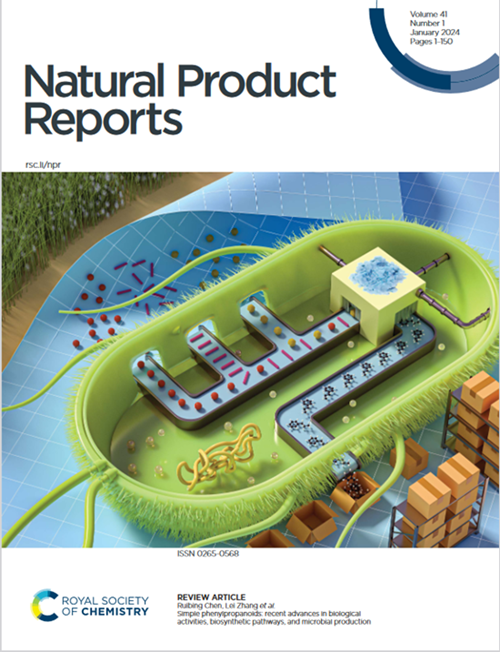Siccanin-related drimane meroterpenoids: biological activities and synthesis†‡
IF 10.6
1区 化学
Q1 BIOCHEMISTRY & MOLECULAR BIOLOGY
引用次数: 0
Abstract
Covering: 1962 to 2023
Drimane (hydro)quinones biosynthetically arise from the combination of drimane-type terpenoids with phenols or equivalents. Since the isolation of siccanin in 1962 (structure identified in 1967), over 200 natural drimane (hydro)quinones have been reported. They are widespread with remarkably diverse architectures and biological functions, which are achieved by varying either the drimane subunit, hydroquinone segment, or the fusion types of drimane and hydroquinone segment both of them. This type of natural products has drawn increasing attention in the discovery of novel pharmaceutical leads. Enormous efforts have been devoted to developing efficient and divergent synthesis approaches to facilitate the SAR study of drimane (hydro)quinones, aiming for more promising functional leads. This review is arranged mainly in terms of scaffold types of drimane (hydro)quinones and further categorized on the basis of biological functions. The mechanisms of action are also briefly discussed. Synthetic methods are categorized according to the strategies forging the Csp2–Csp3 linker between drimane segments and (hydro)quinone subunits.

Siccanin-related drimane meroterpenoids: biological activities and synthesis.
覆盖范围:1962 年至 2023 年1962年至2023年三氢(氢)醌类化合物的生物合成源于钻烷型萜类化合物与酚类或等价物的结合。自 1962 年分离出西卡宁(1967 年确定其结构)以来,已报道了 200 多种天然 drimane(氢)醌类化合物。它们的结构和生物功能广泛多样,可通过改变钻烷亚基、对苯二酚段或钻烷和对苯二酚段的融合类型来实现。这类天然产物在发现新型药物线索方面引起了越来越多的关注。人们一直致力于开发高效、多样化的合成方法,以促进对二氢(氢)醌类化合物的 SAR 研究,从而寻找更有前景的功能性线索。本综述主要按二氢(氢)醌的支架类型进行编排,并根据生物功能进一步分类。此外,还简要讨论了其作用机制。合成方法根据在 drimane 片段和(氢)醌亚基之间形成 Csp2-Csp3 连接的策略进行分类。
本文章由计算机程序翻译,如有差异,请以英文原文为准。
求助全文
约1分钟内获得全文
求助全文
来源期刊

Natural Product Reports
化学-生化与分子生物学
CiteScore
21.20
自引率
3.40%
发文量
127
审稿时长
1.7 months
期刊介绍:
Natural Product Reports (NPR) serves as a pivotal critical review journal propelling advancements in all facets of natural products research, encompassing isolation, structural and stereochemical determination, biosynthesis, biological activity, and synthesis.
With a broad scope, NPR extends its influence into the wider bioinorganic, bioorganic, and chemical biology communities. Covering areas such as enzymology, nucleic acids, genetics, chemical ecology, carbohydrates, primary and secondary metabolism, and analytical techniques, the journal provides insightful articles focusing on key developments shaping the field, rather than offering exhaustive overviews of all results.
NPR encourages authors to infuse their perspectives on developments, trends, and future directions, fostering a dynamic exchange of ideas within the natural products research community.
 求助内容:
求助内容: 应助结果提醒方式:
应助结果提醒方式:


